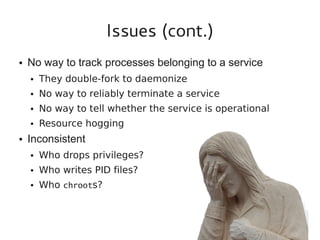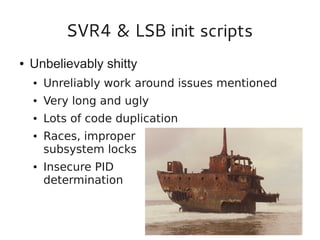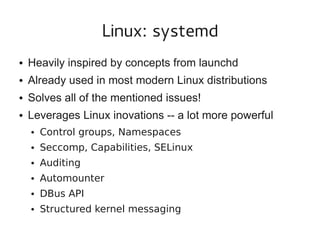This document provides a history of Unix and Linux service management from the early days of /etc/init through the development of systemd. It describes the issues with early init systems like limitations in flexibility, lack of monitoring, and inconsistencies. It then discusses how various operating systems attempted to address these problems through tools like SMF, launchd, upstart, and others. Finally, it provides an overview of how systemd comprehensively solves the issues through features like unit files, control groups, journald logging, and integration with the Linux kernel.
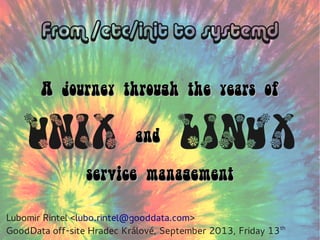
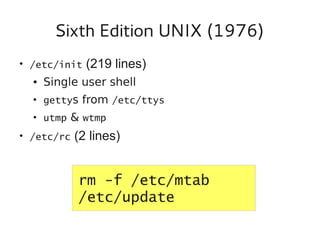



![#ident
"@(#)/etc/init.d/cron.sl 1.1 4.0 10/15/90 8479 AT&T-SF"
#
cron control
pid=`/usr/bin/ps -e | /usr/bin/grep cron |
/usr/bin/sed -e 's/^ *//' -e 's/ .*//'`
case $1 in
'start')
if [ "${pid}" = "" ]
then
/usr/bin/rm -f /etc/cron.d/FIFO
if [ -x /usr/bin/cron ]
then
/usr/bin/cron
elif [ -x /usr/sbin/cron ]
then
/usr/sbin/cron
fi
fi
;;
'stop')
if [ "${pid}" != "" ]
then
/usr/bin/kill ${pid}
fi
;;
*)
echo "usage: /etc/init.d/cron {start|stop}"
;;
esac](https://image.slidesharecdn.com/systemd-130910144808-phpapp01/85/A-journey-through-the-years-of-UNIX-and-Linux-service-management-6-320.jpg)


![#!/bin/bash
#
# sendmail
This shell script takes care of starting and stopping
#
sendmail.
#
# chkconfig: 2345 80 30
# description: Sendmail is a Mail Transport Agent, which is the program
#
that moves mail from one machine to another.
# processname: sendmail
# config: /etc/mail/sendmail.cf
# pidfile: /var/run/sendmail.pid
if [ -x /usr/bin/make -a -f /etc/mail/Makefile ]; then
make all -C /etc/mail -s > /dev/null
else
for i in virtusertable access domaintable mailertable ; do
if [ -f /etc/mail/$i ] ; then
makemap hash /etc/mail/$i < /etc/mail/$i
fi
done
fi
daemon /usr/sbin/sendmail $([ "x$DAEMON" = xyes ] && echo -bd)
$([ -n "$QUEUE" ] && echo -q$QUEUE)
RETVAL=$?
killproc sendmail -HUP
RETVAL=$?
echo
if [ $RETVAL -eq 0 -a -f /var/run/sm-client.pid ]; then
echo -n $"reloading sm-client: "
killproc sm-client -HUP
RETVAL=$?
echo
fi
return $RETVAL
# Source function library.
. /etc/rc.d/init.d/functions
# Source networking configuration.
[ -f /etc/sysconfig/network ] && . /etc/sysconfig/network
# Source sendmail configureation.
if [ -f /etc/sysconfig/sendmail ] ; then
. /etc/sysconfig/sendmail
else
DAEMON=no
QUEUE=1h
fi
[ -z "$SMQUEUE" ] && SMQUEUE="$QUEUE"
[ -z "$SMQUEUE" ] && SMQUEUE=1h
}
stop() {
# Stop daemons.
if test -f /var/run/sm-client.pid ; then
echo -n $"Shutting down sm-client: "
killproc sm-client
RETVAL=$?
echo
[ $RETVAL -eq 0 ] && rm -f /var/run/sm-client.pid
[ $RETVAL -eq 0 ] && rm -f /var/lock/subsys/sm-client
fi
echo -n $"Shutting down $prog: "
killproc sendmail
RETVAL=$?
echo
[ $RETVAL -eq 0 ] && rm -f /var/lock/subsys/sendmail
return $RETVAL
# Check that networking is up.
[ "${NETWORKING}" = "no" ] && exit 0
[ -f /usr/sbin/sendmail ] || exit 0
RETVAL=0
prog="sendmail"
start() {
# Start daemons.
echo -n $"Starting $prog: "
if test -x /usr/bin/make -a -f /etc/mail/Makefile ; then
make all -C /etc/mail -s > /dev/null
else
for i in virtusertable access domaintable mailertable ; do
if [ -f /etc/mail/$i ] ; then
makemap hash /etc/mail/$i < /etc/mail/$i
fi
done
fi
/usr/bin/newaliases > /dev/null 2>&1
daemon /usr/sbin/sendmail $([ "x$DAEMON" = xyes ] && echo -bd)
$([ -n "$QUEUE" ] && echo -q$QUEUE) $SENDMAIL_OPTARG
RETVAL=$?
echo
[ $RETVAL -eq 0 ] && touch /var/lock/subsys/sendmail
if ! test -f /var/run/sm-client.pid ; then
echo -n $"Starting sm-client: "
touch /var/run/sm-client.pid
chown smmsp:smmsp /var/run/sm-client.pid
if [ -x /usr/sbin/selinuxenabled ] && /usr/sbin/selinuxenabled; then
/sbin/restorecon /var/run/sm-client.pid
fi
daemon --check sm-client /usr/sbin/sendmail -L sm-msp-queue -Ac
-q$SMQUEUE $SENDMAIL_OPTARG
RETVAL=$?
echo
[ $RETVAL -eq 0 ] && touch /var/lock/subsys/sm-client
fi
return $RETVAL
reload() {
# Stop daemons.}
echo -n $"reloading $prog: "
/usr/bin/newaliases > /dev/null 2>&1
}
# See how we were called.
case "$1" in
start)
start
;;
stop)
stop
;;
reload)
reload
RETVAL=$?
;;
restart)
stop
start
RETVAL=$?
;;
condrestart)
if [ -f /var/lock/subsys/sendmail ]; then
stop
start
RETVAL=$?
fi
;;
status)
status sendmail
RETVAL=$?
;;
*)
echo $"Usage: $0 {start|stop|restart|condrestart|status}"
exit 1
esac
exit $RETVAL](https://image.slidesharecdn.com/systemd-130910144808-phpapp01/85/A-journey-through-the-years-of-UNIX-and-Linux-service-management-9-320.jpg)


